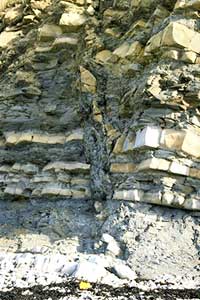  For a review of fault seal analysis see Skerlec, G.M. (1999) Evaluating Fault Seal & Top Seal in Exploring for Oil & Gas Traps (Beaumont/Foster eds.), the newest volume in the AAPG Treatise of Petroleum Geology For a review of fault seal analysis see Skerlec, G.M. (1999) Evaluating Fault Seal & Top Seal in Exploring for Oil & Gas Traps (Beaumont/Foster eds.), the newest volume in the AAPG Treatise of Petroleum Geology
|
In more than 12 major hydrocarbons basins, as diverse as the North Sea and the Gulf Coast, fault seal behavior is related to gouge composition and juxtaposition relationships along the fault. Juxtaposition relationships are inferred from fault plane profiles. Quantitative fault seal analysis estimates the sand/shale composition of the gouge and empirically relates seal and gouge composition. Sand-rich gouge tends to leak. Shale-rich gouge tends to seal. Despite the variety of processes controlling seal behavior, gouge composition remains a first order control on fault seal. For other risks see RISKS
Fault Plane Profiles Quantitative Fault Seal Analysis Analogs Migration Pathway Maps
| | "Fault seal behavior isn't random. There is a pattern and once the pattern is understood, seal can be predicted with a high degree of confidence. There are different risks in different basins; different risks in different traps." |



